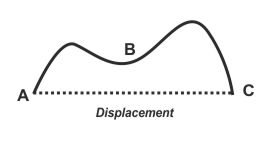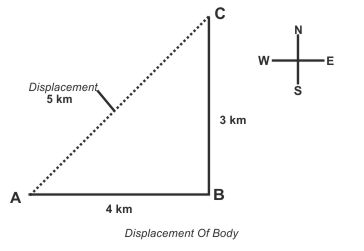
The shortest distance (straight line) between the start position and end position of a moving rigid body in a particular direction is known as displacement of that body.
Example

Let a body travel from A to C position through the point B. that is, that body travels the path ABC. Here the start position is A and end position is C. Now we connect A and C by a straight line. Here AC is the displacement of the body which direction is from A to C. Both value and direction of the displacement is required to explain the displacement of the body. Displacement is a vector quantity, because it has both value and direction.
Another Example,
You travel from the point A to B (4KM) towards the east and then after from B to C (3KM) towards the north. Then the distance travel by you is
AB + BC = 4km + 3km = 7km

But displacement of the person is AC which can be calculated by the Pythagoras’ theorem.


If a moving body travels in a circular path and reaches at the starting point after one revolution then the distance travel by the moving body is equal to the circumference of the circular path. But the displacement is Zero. Because starting point and end point of the body is equal.
The unit of the displacement is
|
Displacement |
Distance |
|
The shortest distance between start and final position of a moving body is known as displacement |
Total path travel by a moving body is known as distance. |
|
It is a vector quantity, because it have both value and direction |
It is a scalar quantity, because it have value but no direction. |